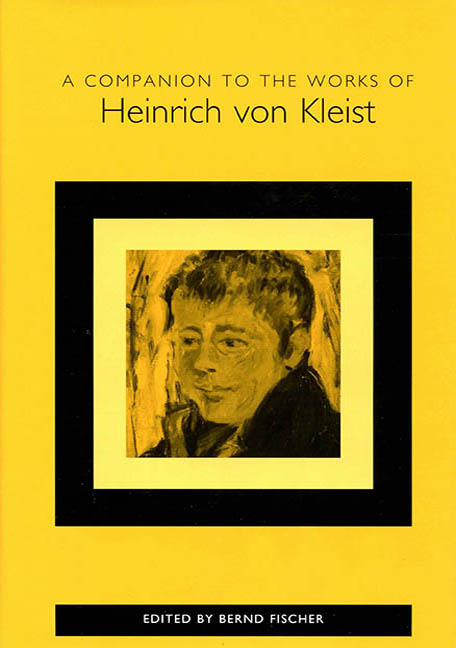Book contents
- Frontmatter
- Contents
- Introduction: Heinrich von Kleist's Life and Work
- Critical Approaches
- Language and Form
- On Structures in Kleist
- Strange News: Kleist's Novellas
- The Eye of the Beholder: Kleist's Visual Poetics of Knowledge
- The Performative Turn of the Beautiful: “Free Play” of Language and the “Unspeakable Person”
- Intellectual Paradigms
- Themes and Motifs
- Notes on the Contributors
- Index
Strange News: Kleist's Novellas
from Language and Form
Published online by Cambridge University Press: 27 April 2017
- Frontmatter
- Contents
- Introduction: Heinrich von Kleist's Life and Work
- Critical Approaches
- Language and Form
- On Structures in Kleist
- Strange News: Kleist's Novellas
- The Eye of the Beholder: Kleist's Visual Poetics of Knowledge
- The Performative Turn of the Beautiful: “Free Play” of Language and the “Unspeakable Person”
- Intellectual Paradigms
- Themes and Motifs
- Notes on the Contributors
- Index
Summary
In der Kunst kommt es überall auf die Form an, und alles was eine Gestalt hat, ist meine Sache” (Kleist 2:810). Kleist's narratives have been seen as exemplary for the revival of novelistic form in German nineteenth-century literature after the Renaissance genre was rediscovered by Goethe and the Romantics. Organized around semantic oppositions with a moralistic bent — the violation of law and just punishment in “Der Zweikampf” and “Michael Kohlhaas,” erotic desire and superior moral sense in “Die Marquise von O …,” magnanimity and slyness in “Der Findling,” trust and treason in “Die Verlobung in St. Domingo,” the suspension of a social order and its restitution in “Das Erdbeben in Chili” — Kleist's stories seem to adopt the basic structural model of the novella and of the novella's revision of its immediate precursor, the exemplum. With a clear reference to that literary tradition, Kleist had even contemplated titling the first edition of his collected stories, to be published in 1811, “Moralische Erzählungen” (2:835). Kleist's fierce poetic imagination — the baby held to be Jeronimo and Josephe's illegitimate son is smashed against the edge of a church pillar, Piachi crushes Nicolo's brains out against the wall — however, does not mark the departure from the older genre conventions (Marx 9). Disturbing as it may have been to a late-eighteenth-century sensibility, literary fantasies of gruesome outrage or brutish revenge are characteristic of novelistic material in general (in the variations on the Herzmaere, for instance, the duped husband or upset father serves up the torn-out heart or cut-off head of the lover to his wife or daughter) and directly derive from the sources on which Kleist draws for “Das Erdbeben in Chili” and “Der Findling.” The seventh novella told on the fifth day in Boccaccio's Decamerone reports the fate of the slave Teodoro, who had fallen in love with his master's daughter Violante. When Violante's pregnancy is discovered, Teodoro is sentenced to death; her outraged father wants to force Violante to chose between poison and dagger and to have her illegitimate child “smashed against the wall” (Boccaccio 494, my translation). By coincidence, Teodoro's father, an influential Armenian diplomat, recognizes his long-lost son on the latter's way to the gallows and has the verdict suspended, and the lovers, now no longer different in social standing, can be happily and legitimately reunited.
- Type
- Chapter
- Information
- A Companion to the Works of Heinrich von Kleist , pp. 81 - 102Publisher: Boydell & BrewerPrint publication year: 2003



